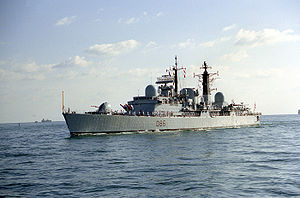
Back Třída Sheffield Czech Sheffield-klassen Danish Sheffield-Klasse German Destructor Tipo 42 Spanish ناوشکن تیپ ۴۲ Persian Tyyppi 42 -hävittäjä Finnish Type 42 (destroyer) French Classe Type 42 Italian 42型駆逐艦 Japanese Sheffield-klassen (Type 42) NB
This article needs additional citations for verification. (October 2017) |
 HMS Birmingham
| |
| Class overview | |
|---|---|
| Name | Type 42 |
| Builders | Vickers, Cammell-Laird, Swan Hunter, Vosper Thorneycroft, CFNE Argentina |
| Operators |
|
| Preceded by | |
| Succeeded by |
|
| Subclasses | Batches 1, 2 and 3 |
| In service | 1975–2013 |
| Completed | 16 |
| Lost | UK: 2 (Falklands War) |
| Retired | 14 |
| General characteristics | |
| Type | Guided-missile destroyer |
| Displacement | |
| Length | |
| Beam | |
| Draught | |
| Decks | 8 |
| Installed power | 50,000 shp (37 MW) |
| Propulsion |
|
| Speed |
|
| Range | 4,200 nmi (7,800 km; 4,800 mi) single Tyne RM1C/other shaft trailing at 13.8 kn (25.6 km/h; 15.9 mph) |
| Boats & landing craft carried | 2 |
| Complement | |
| Sensors and processing systems | |
| Electronic warfare & decoys |
|
| Armament |
|
| Aircraft carried |
|
| Aviation facilities | Flight deck and enclosed hangar for embarking one helicopter |
The Type 42 or Sheffield class, was a class of fourteen guided-missile destroyers that served in the Royal Navy.[4] A further two ships of this class were built for and served with the Argentine Navy.
The first ship of the class was ordered in 1968 and launched in 1971. Two of the class (Sheffield and Coventry) were lost to enemy action during the Falklands War of 1982. The Royal Navy used this class of destroyer for 38 years between 1975 and 2013.
No ships of this class remain active in the Royal Navy and both have also been retired from the Argentine Navy. The Royal Navy has replaced them with Type 45 destroyers.
- ^ a b c d e f g h i j k l m n o Sharpe, Richard, Jane's Fighting Ships 1992–93, pub Janes Information Group, 1992, ISBN 0-7106-0983-3, pp. 696–7
- ^ a b c d e f g h Heyman, Charles The Armed Forces of the United Kingdom 1999–2000, pub Pen and Sword, 1998, ISBN 978-0-85052-621-9, pp. 40–41
- ^ Royal Navy (11 July 2013). A Global Force 2012/13 (PDF). Newsdesk Media. ISBN 978-1-906940-75-1. Archived from the original (PDF) on 21 September 2018. Complement as of 24 April 2013
- ^ Marriott, Leo: Royal Navy Destroyers since 1945, ISBN 0-7110-1817-0, Ian Allan Ltd, 1989